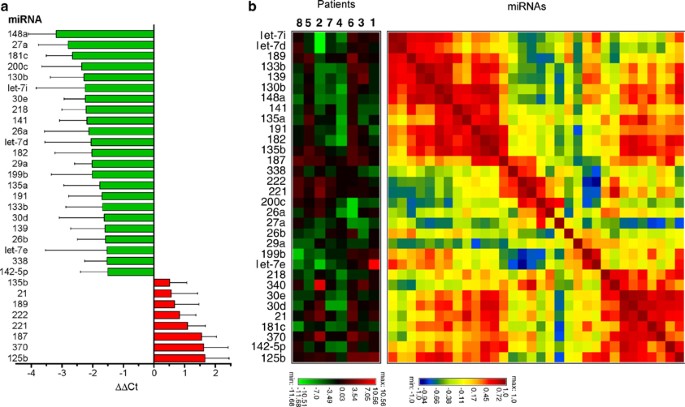
- Select a language for the TTS:
- UK English Female
- UK English Male
- US English Female
- US English Male
- Australian Female
- Australian Male
- Language selected: (auto detect) - EN
Play all audios:
ABSTRACT MicroRNAs (miRNAs) are endogenous non-coding RNAs that are known to be involved in the pathogenesis of tumors. Gastric carcinoma (GC) is a common malignancy worldwide. The aim of
this study was the identification of the expression signature and functional roles of aberrant miRNAs in GC. Initial screening established a profile of aberrantly expressed miRNAs in tumors.
_miR-370_ was confirmed to be overexpressed in GC tissues. Higher expression of _miR-370_ in GC tissues was associated with more advanced nodal metastasis and a higher clinical stage
compared with controls. In addition, significantly higher level of _miR-370_ was noted in the plasma of GC patients compared with controls. Patients having more invasive or advanced tumors
also exhibited a higher plasma level of _miR-370_. _In vitro_ assays indicated that exogenous _miR-370_ expression enhanced the oncogenic potential of GC cells. The AGS-GFPM2 cells with
exogenous _miR-370_ expression also exhibited enhanced abdominal metastatic dissemination in nude mice. Reporter assays confirmed that _miR-370_ targeted predicted sites in 3′UTR of
_transforming growth factor-β receptor II_ (_TGFβ-RII_) gene. The exogenous _miR-370_ expression decreased _TGFβ-RII_ expression and the phosphorylation of Smad3 elicited by TGFβ1. The
TGFβ1-mediated repression in cell migration was reverted by exogenous _miR-370_ expression. A reverse correlation between _miR-370_ and TGFβ-RII expression was noted in GC tissues. This
study concludes that _miR-370_ is a miRNA that is associated with GC progression by downregulating _TGFβ-RII_. The miRNA expression profile described in this study should contribute to
future studies on the role of miRNAs in GC. Access through your institution Buy or subscribe This is a preview of subscription content, access via your institution ACCESS OPTIONS Access
through your institution Subscribe to this journal Receive 50 print issues and online access $259.00 per year only $5.18 per issue Learn more Buy this article * Purchase on SpringerLink *
Instant access to full article PDF Buy now Prices may be subject to local taxes which are calculated during checkout ADDITIONAL ACCESS OPTIONS: * Log in * Learn about institutional
subscriptions * Read our FAQs * Contact customer support SIMILAR CONTENT BEING VIEWED BY OTHERS MICRORNAS ARE INVOLVED IN THE DEVELOPMENT AND PROGRESSION OF GASTRIC CANCER Article 09 October
2020 THE MIR-532-E2F1 FEEDBACK LOOP CONTRIBUTES TO GASTRIC CANCER PROGRESSION Article Open access 19 April 2022 NOVEL PROGNOSTIC MARKER LINC00205 PROMOTES TUMORIGENESIS AND METASTASIS BY
COMPETITIVELY SUPPRESSING MIRNA-26A IN GASTRIC CANCER Article Open access 10 January 2022 REFERENCES * Ando T, Yoshida T, Enomoto S, Asada K, Tatematsu M, Ichinose M _et al_. (2008). DNA
methylation of microRNA genes in gastric mucosae of gastric cancer patients: Its possible involvement in the formation of epigenetic field defect. _Int J Cancer_ 124: 2367–2374. Article
Google Scholar * Bartel DP . (2009). MicroRNAs: target recognition and regulatory functions. _Cell_ 136: 215–233. Article CAS PubMed PubMed Central Google Scholar * Brown BD, Naldini L
. (2009). Exploiting and antagonizing microRNA regulation for therapeutic and experimental applications. _Nat Rev Genet_ 10: 578–585. Article CAS PubMed Google Scholar * Castilla MA,
Moreno-Bueno G, Romero-Perez L, Van De Vijver K, Biscuola M, Lopez-Garcia MA _et al_. (2011). Micro-RNA signature of the epithelial-mesenchymal transition in endometrial carcinosarcoma. _J
Pathol_ 223: 72–80. Article CAS PubMed Google Scholar * Chen X, Ba Y, Ma L, Cai X, Yin Y, Wang K _et al_. (2008). Characterization of microRNAs in serum: a novel class of biomarkers for
diagnosis of cancer and other diseases. _Cell Res_ 18: 997–1006. Article CAS PubMed Google Scholar * Chen Y, Stallings RL . (2007). Differential patterns of microRNA expression in
neuroblastoma are correlated with prognosis, differentiation, and apoptosis. _Cancer Res_ 67: 976–983. Article CAS PubMed Google Scholar * Dalmay T, Edwards DR . (2006). MicroRNAs and
the hallmarks of cancer. _Oncogene_ 25: 6170–6175. Article CAS PubMed Google Scholar * Dixon-McIver A, East P, Mein CA, Cazier JB, Molloy G, Chaplin T _et al_. (2008). Distinctive
patterns of microRNA expression associated with karyotype in acute myeloid leukaemia. _PLoS One_ 3: e2141. Article PubMed PubMed Central Google Scholar * Ehata S, Johansson E, Katayama
R, Koike S, Watanabe A, Hoshino Y _et al_. (2011). Transforming growth factor-beta decreases the cancer-initiating cell population within diffuse-type gastric carcinoma cells. _Oncogene_ 30:
1693–1705. Article CAS PubMed Google Scholar * Hayashita Y, Osada H, Tatematsu Y, Yamada H, Yanagisawa K, Tomida S _et al_. (2005). A polycistronic microRNA cluster, miR-17-92, is
overexpressed in human lung cancers and enhances cell proliferation. _Cancer Res_ 65: 9628–9632. Article CAS PubMed Google Scholar * Hsu KW, Hsieh RH, Wu CW, Chi CW, Lee YH, Kuo ML _et
al_. (2009). MBP-1 suppresses growth and metastasis of gastric cancer cells through COX-2. _Mol Biol Cell_ 20: 5127–5137. Article CAS PubMed PubMed Central Google Scholar * Inman GJ,
Nicolas FJ, Callahan JF, Harling JD, Gaster LM, Reith AD _et al_. (2002). SB-431542 is a potent and specific inhibitor of transforming growth factor-beta superfamily type I activin
receptor-like kinase (ALK) receptors ALK4, ALK5, and ALK7. _Mol Pharmacol_ 62: 65–74. Article CAS PubMed Google Scholar * Johnson SM, Grosshans H, Shingara J, Byrom M, Jarvis R, Cheng A
_et al_. (2005). RAS is regulated by the let-7 microRNA family. _Cell_ 120: 635–647. Article CAS PubMed Google Scholar * Ju HR, Jung U, Sonn CH, Yoon SR, Jeon JH, Yang Y _et al_. (2003).
Aberrant signaling of TGF-beta1 by the mutant Smad4 in gastric cancer cells. _Cancer Lett_ 196: 197–206. Article CAS PubMed Google Scholar * Katada T, Ishiguro H, Kuwabara Y, Kimura M,
Mitui A, Mori Y _et al_. (2009). microRNA expression profile in undifferentiated gastric cancer. _Int J Oncol_ 34: 537–542. CAS PubMed Google Scholar * Kim YK, Yu J, Han TS, Park SY,
Namkoong B, Kim DH _et al_. (2009). Functional links between clustered microRNAs: suppression of cell-cycle inhibitors by microRNA clusters in gastric cancer. _Nucleic Acids Res_ 37:
1672–1681. Article CAS PubMed PubMed Central Google Scholar * Komuro A, Yashiro M, Iwata C, Morishita Y, Johansson E, Matsumoto Y _et al_. (2009). Diffuse-type gastric carcinoma:
progression, angiogenesis, and transforming growth factor beta signaling. _J Natl Cancer Inst_ 101: 592–604. Article CAS PubMed PubMed Central Google Scholar * Ladeiro Y, Couchy G,
Balabaud C, Bioulac-Sage P, Pelletier L, Rebouissou S _et al_. (2008). MicroRNA profiling in hepatocellular tumors is associated with clinical features and oncogene/tumor suppressor gene
mutations. _Hepatology_ 47: 1955–1963. Article CAS PubMed Google Scholar * Le MT, Teh C, Shyh-Chang N, Xie H, Zhou B, Korzh V _et al_. (2009). MicroRNA-125b is a novel negative regulator
of p53. _Genes Dev_ 23: 862–876. Article CAS PubMed PubMed Central Google Scholar * Lin HL, Yang MH, Wu CW, Chen PM, Yang YP, Chu YR _et al_. (2007). 2-Methoxyestradiol attenuates
phosphatidylinositol 3-kinase/Akt pathway-mediated metastasis of gastric cancer. _Int J Cancer_ 121: 2547–2555. Article CAS PubMed Google Scholar * Liu CJ, Tsai MM, Hung PS, Kao SY, Liu
TY, Wu KJ _et al_. (2010). miR-31 ablates expression of the HIF regulatory factor FIH to activate the HIF pathway in head and neck carcinoma. _Cancer Res_ 70: 1635–1644. Article CAS PubMed
Google Scholar * Liu T, Papagiannakopoulos T, Puskar K, Qi S, Santiago F, Clay W _et al_. (2007). Detection of a microRNA signal in an _in vivo_ expression set of mRNAs. _PLoS One_ 2:
e804. Article PubMed PubMed Central Google Scholar * Liu T, Tang H, Lang Y, Liu M, Li X . (2009). MicroRNA-27a functions as an oncogene in gastric adenocarcinoma by targeting prohibitin.
_Cancer Lett_ 273: 233–242. Article CAS PubMed Google Scholar * Lo SS, Chen JH, Wu CW, Lui WY . (2009). Functional polymorphism of NFKB1 promoter may correlate to the susceptibility of
gastric cancer in aged patients. _Surgery_ 145: 280–285. Article PubMed Google Scholar * Lu Z, Liu M, Stribinskis V, Klinge CM, Ramos KS, Colburn NH _et al_. (2008). MicroRNA-21 promotes
cell transformation by targeting the programmed cell death 4 gene. _Oncogene_ 27: 4373–4379. Article CAS PubMed Google Scholar * Lujambio A, Calin GA, Villanueva A, Ropero S,
Sanchez-Cespedes M, Blanco D _et al_. (2008). A microRNA DNA methylation signature for human cancer metastasis. _Proc Natl Acad Sci USA_ 105: 13556–13561. Article CAS PubMed PubMed
Central Google Scholar * Massague J . (2008). TGFbeta in Cancer. _Cell_ 134: 215–230. Article CAS PubMed PubMed Central Google Scholar * Meng F, Henson R, Lang M, Wehbe H, Maheshwari
S, Mendell JT _et al_. (2006). Involvement of human micro-RNA in growth and response to chemotherapy in human cholangiocarcinoma cell lines. _Gastroenterology_ 130: 2113–2129. Article CAS
PubMed Google Scholar * Meng F, Wehbe-Janek H, Henson R, Smith H, Patel T . (2008). Epigenetic regulation of microRNA-370 by interleukin-6 in malignant human cholangiocytes. _Oncogene_ 27:
378–386. Article CAS PubMed Google Scholar * Motoyama K, Inoue H, Nakamura Y, Uetake H, Sugihara K, Mori M . (2008). Clinical significance of high mobility group A2 in human gastric
cancer and its relationship to let-7 microRNA family. _Clin Cancer Res_ 14: 2334–2340. Article CAS PubMed Google Scholar * Ng EK, Chong WW, Jin H, Lam EK, Shin VY, Yu J _et al_. (2009).
Differential expression of microRNAs in plasma of colorectal cancer patients: a potential marker for colorectal cancer screening. _Gut_ 58: 1375–1381. Article CAS PubMed Google Scholar *
Ohshima K, Inoue K, Fujiwara A, Hatakeyama K, Kanto K, Watanabe Y _et al_. (2010). Let-7 microRNA family is selectively secreted into the extracellular environment via exosomes in a
metastatic gastric cancer cell line. _PLoS One_ 5: e13247. Article PubMed PubMed Central Google Scholar * Petrocca F, Visone R, Onelli MR, Shah MH, Nicoloso MS, de Martino I _et al_.
(2008). E2F1-regulated microRNAs impair TGFbeta-dependent cell-cycle arrest and apoptosis in gastric cancer. _Cancer Cell_ 13: 272–286. Article CAS PubMed Google Scholar * Scott GK, Goga
A, Bhaumik D, Berger CE, Sullivan CS, Benz CC . (2007). Coordinate suppression of ERBB2 and ERBB3 by enforced expression of micro-RNA miR-125a or miR-125b. _J Biol Chem_ 282: 1479–1486.
Article CAS PubMed Google Scholar * Selbach M, Schwanhausser B, Thierfelder N, Fang Z, Khanin R, Rajewsky N . (2008). Widespread changes in protein synthesis induced by microRNAs.
_Nature_ 455: 58–63. Article CAS PubMed Google Scholar * Si ML, Zhu S, Wu H, Lu Z, Wu F, Mo YY . (2007). miR-21-mediated tumor growth. _Oncogene_ 26: 2799–2803. Article CAS PubMed
Google Scholar * van den Brink GR, Offerhaus GJ . (2007). The morphogenetic code and colon cancer development. _Cancer Cell_ 11: 109–117. Article CAS PubMed Google Scholar * Volinia S,
Calin GA, Liu CG, Ambs S, Cimmino A, Petrocca F _et al_. (2006). A microRNA expression signature of human solid tumors defines cancer gene targets. _Proc Natl Acad Sci USA_ 103: 2257–2261.
Article CAS PubMed PubMed Central Google Scholar * Wu CW, Hsiung CA, Lo SS, Hsieh MC, Chen JH, Li AF _et al_. (2006). Nodal dissection for patients with gastric cancer: a randomised
controlled trial. _Lancet Oncol_ 7: 309–315. Article CAS PubMed Google Scholar * Yanaihara N, Caplen N, Bowman E, Seike M, Kumamoto K, Yi M _et al_. (2006). Unique microRNA molecular
profiles in lung cancer diagnosis and prognosis. _Cancer Cell_ 9: 189–198. Article CAS PubMed Google Scholar * Yoshino H, Chiyomaru T, Enokida H, Kawakami K, Tatarano S, Nishiyama K _et
al_. (2011). The tumour-suppressive function of miR-1 and miR-133a targeting TAGLN2 in bladder cancer. _Br J Cancer_ 104: 808–818. Article CAS PubMed PubMed Central Google Scholar *
Zhang Z, Li Z, Gao C, Chen P, Chen J, Liu W _et al_. (2008). miR-21 plays a pivotal role in gastric cancer pathogenesis and progression. _Lab Invest_ 88: 1358–1366. Article CAS PubMed
Google Scholar * Zhu S, Si ML, Wu H, Mo YY . (2007). MicroRNA-21 targets the tumor suppressor gene tropomyosin 1 (TPM1). _J Biol Chem_ 282: 14328–14336. Article CAS PubMed Google Scholar
Download references ACKNOWLEDGEMENTS We acknowledge helps from Dr Shu-Chun Lin, Dr Kuo-Wei Chang, Ms Yu-Pin Chen, Mr Shi-Wen Chen and Mr Chung-Sheng Chou. This study was supported by grant
96-2314-B-010-055-MY3 from National Science Council, and National Yang-Ming University Hospital Grant RD 2008-001. AUTHOR INFORMATION AUTHORS AND AFFILIATIONS * Department of Medicine,
School of Medicine, National Yang-Ming University, Taipei, Taiwan S-S Lo, W-L Fang, C-Y Chen, W-T Chen & C-W Wu * Department of Surgery, National Yang-Ming University Hospital, Yi-Lan,
Taiwan S-S Lo, C-Y Chen & W-T Chen * Department of Dentistry, National Yang-Ming University Hospital, Yi-Lan, Taiwan P-S Hung, H-F Tu & N-R Gong * Division of General Surgery,
Department of Surgery, Taipei Veterans General Hospital, Taipei, Taiwan J-H Chen, W-L Fang & C-W Wu Authors * S-S Lo View author publications You can also search for this author inPubMed
Google Scholar * P-S Hung View author publications You can also search for this author inPubMed Google Scholar * J-H Chen View author publications You can also search for this author
inPubMed Google Scholar * H-F Tu View author publications You can also search for this author inPubMed Google Scholar * W-L Fang View author publications You can also search for this author
inPubMed Google Scholar * C-Y Chen View author publications You can also search for this author inPubMed Google Scholar * W-T Chen View author publications You can also search for this
author inPubMed Google Scholar * N-R Gong View author publications You can also search for this author inPubMed Google Scholar * C-W Wu View author publications You can also search for this
author inPubMed Google Scholar CORRESPONDING AUTHOR Correspondence to S-S Lo. ETHICS DECLARATIONS COMPETING INTERESTS The authors declare no conflict of interest. ADDITIONAL INFORMATION
Supplementary Information accompanies the paper on the Oncogene website SUPPLEMENTARY INFORMATION SUPPLEMENTARY MATERIAL (DOC 309 KB) RIGHTS AND PERMISSIONS Reprints and permissions ABOUT
THIS ARTICLE CITE THIS ARTICLE Lo, SS., Hung, PS., Chen, JH. _et al._ Overexpression of _miR-370_ and downregulation of its novel target TGFβ-RII contribute to the progression of gastric
carcinoma. _Oncogene_ 31, 226–237 (2012). https://doi.org/10.1038/onc.2011.226 Download citation * Received: 04 October 2010 * Revised: 29 April 2011 * Accepted: 09 May 2011 * Published: 13
June 2011 * Issue Date: 12 January 2012 * DOI: https://doi.org/10.1038/onc.2011.226 SHARE THIS ARTICLE Anyone you share the following link with will be able to read this content: Get
shareable link Sorry, a shareable link is not currently available for this article. Copy to clipboard Provided by the Springer Nature SharedIt content-sharing initiative KEYWORDS * carcinoma
* microRNA * _miR-370_ * plasma * stomach * TGFβ-RII









